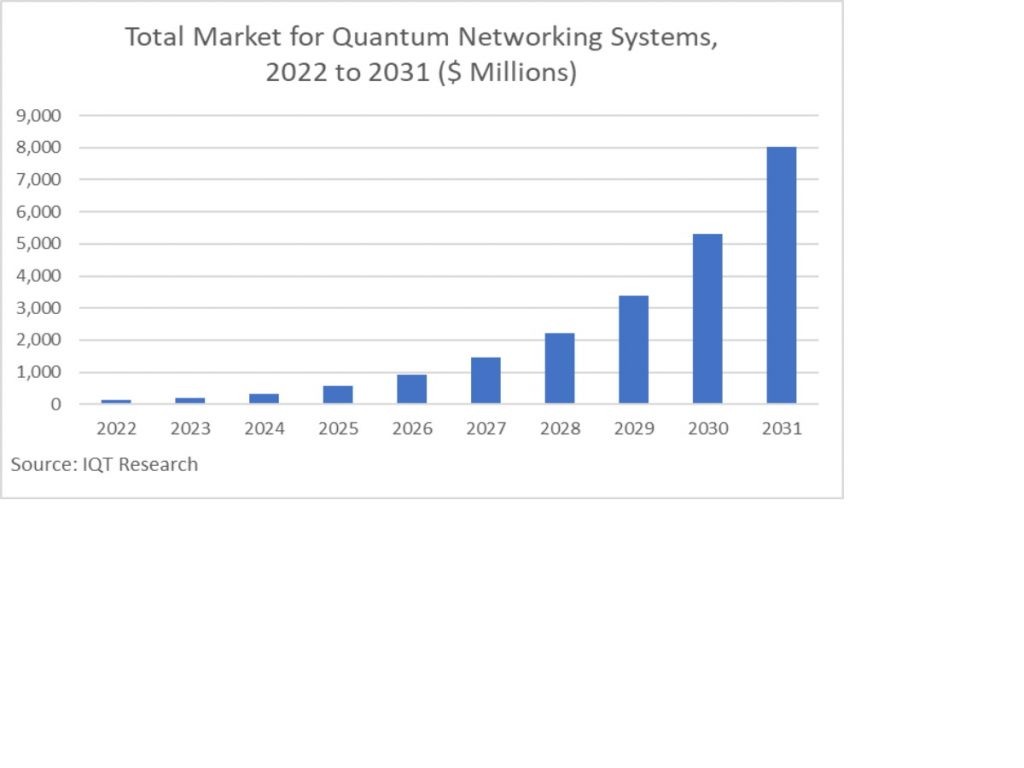According to a new report from IQT Research, the worldwide market for quantum networks will near $1.5 Billion in 2027 and then go on to over $8 Billion by 2031. This revenue growth will be fueled using quantum key distribution (QKD) in many geographies, followed by the rise of networks using quantum repeaters and quantum sensor networks.
More details of the report, Opportunities in Quantum Networks: 2022-2031, can be found at https://www.insidequantumtechnology.com/product/opportunities-in-quantum-networks-2022-to-2031/
For a sample of this report, click on Request Excerpt.
About the Report:
This report analyzes business opportunities in the quantum networking market as it makes a transition to the quantum internet. However, this report is much more than just a market forecast. The bulk of this report is dedicated to an analysis of all the existing quantum networks that already exist around the world. The reader will better understand the goals of the many national, local and regional quantum networks that are being built around the world both by governments and private companies. The geographies covered are North America, the EU, non-EU Europe, China, Asia other than China, Australasia and Russia. In this report we chronicle how the quantum internet will be born and how revenues will be generated from early products and networks during its early years.
The report looks at how global events are shaping the opportunities in the quantum networking space. We examine whether antipathy to QKD by intelligence services will hurt the QKD market. Conversely, we take a look at whether the war in the Ukraine will stimulate the quantum networking business. Recently the Defense Innovation Accelerator for the North Atlantic (DIANA) and Australian, U.K. and U.S. (AUKUS) agreements were announced to further strengthen quantum-related collaborations between western nations in response to both the Ukraine war and the growing threat of Chinese quantum related advances.
This report also discusses how companies are building product and marketing strategies for quantum networks. Some of the large commercial companies covered include Airbus, AWS, BT, Cisco, Deutsche Telekom, Huawei, Juniper, Korea Telecom, LG, Mitsubishi, NEC, Nomura, NTT, Quantum Xchange, Raytheon, Thales, Toshiba, Verizon, and ID Quantique, to name just a few. In addition, we examine start-ups in the quantum networking space.
From the Report:
- Most quantum networks are currently based on QKD. However, with the advent of quantum repeaters a true quantum internet could rapidly spread across the globe. Quantum repeaters will serve as a key enabler for global quantum internets. By 2027 more than $180 million will be spent on building networks with some level of repeater technology.
- Until commercial quantum repeaters become widely available, satellites will play an important role in long-haul quantum networks. There are already impressive examples of satellite quantum communications in Canada (QEYSSat) and China (Micius). In China, 150 industrial users have already been connected to the Micius network. Satellites provide the opportunity to deploy novel value-added quantum services such as QKD-on-demand or entanglement on demand.
- Researchers and startups are finding ways to deploy networked quantum sensors. Quantum sensor networks will be of growing interest in the defense industry — they provide mechanisms for targeting that are secure against jamming. This report considers both classical networks of quantum sensors and future end-to-end quantum sensors networks. By 2027 almost $190 million will be invested in building quantum sensor networks. Right now, quantum sensor networks don’t exist outside lab environments.
For more details on the report, contact:
Lawrence Gasman
lawrence@insidequantumtechnology.com
Telephone: 434-82
